Parakrama Ekanayake
Performance Benchmarking of Psychomotor Skills Using Wearable Devices: An Application in Sport
Nov 25, 2024Abstract:This study proposes a versatile framework for optimizing psychomotor learning through human motion analysis. Utilizing a wearable IMU sensor system, the motion trajectories of a given psychomotor task are acquired and then linked to points in a performance space using a predefined set of quality metrics specific to the psychomotor skill. This enables the identification of a benchmark cluster in the performance space, allowing correspondences to be established between the performance clusters and sets of trajectories in the motion space. As a result, common or specific deviations in the performance space can be identified, enabling remedial actions in the motion space to optimize performance. A thorough validation of the proposed framework is done in this paper using a Table Tennis forehand stroke as a case study. The resulting quantitative and visual representation of performance empowers individuals to optimize their skills and achieve peak performance.
Iso-Diffusion: Improving Diffusion Probabilistic Models Using the Isotropy of the Additive Gaussian Noise
Mar 25, 2024Abstract:Denoising Diffusion Probabilistic Models (DDPMs) have accomplished much in the realm of generative AI. Despite their high performance, there is room for improvement, especially in terms of sample fidelity by utilizing statistical properties that impose structural integrity, such as isotropy. Minimizing the mean squared error between the additive and predicted noise alone does not impose constraints on the predicted noise to be isotropic. Thus, we were motivated to utilize the isotropy of the additive noise as a constraint on the objective function to enhance the fidelity of DDPMs. Our approach is simple and can be applied to any DDPM variant. We validate our approach by presenting experiments conducted on four synthetic 2D datasets as well as on unconditional image generation. As demonstrated by the results, the incorporation of this constraint improves the fidelity metrics, Precision and Density for the 2D datasets as well as for the unconditional image generation.
GAUSS: Guided Encoder-Decoder Architecture for Hyperspectral Unmixing with Spatial Smoothness
Apr 16, 2022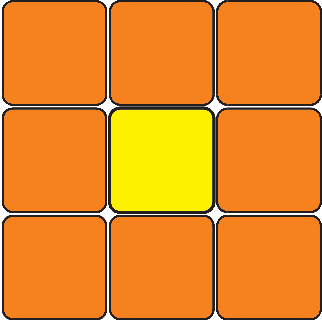
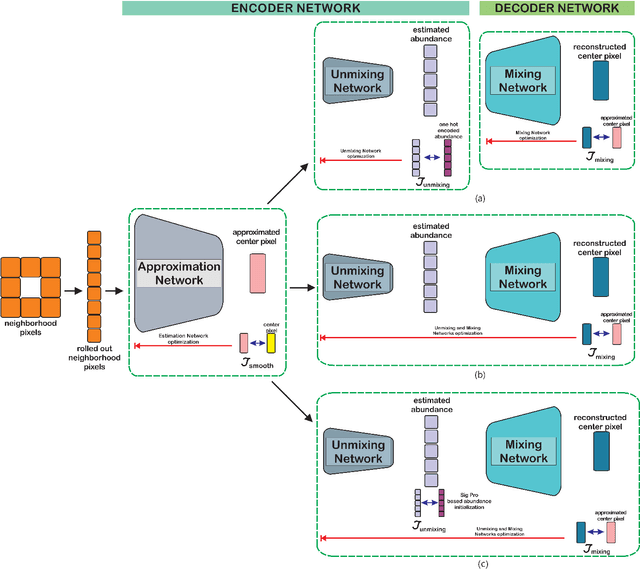
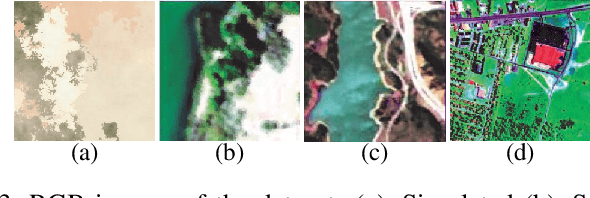
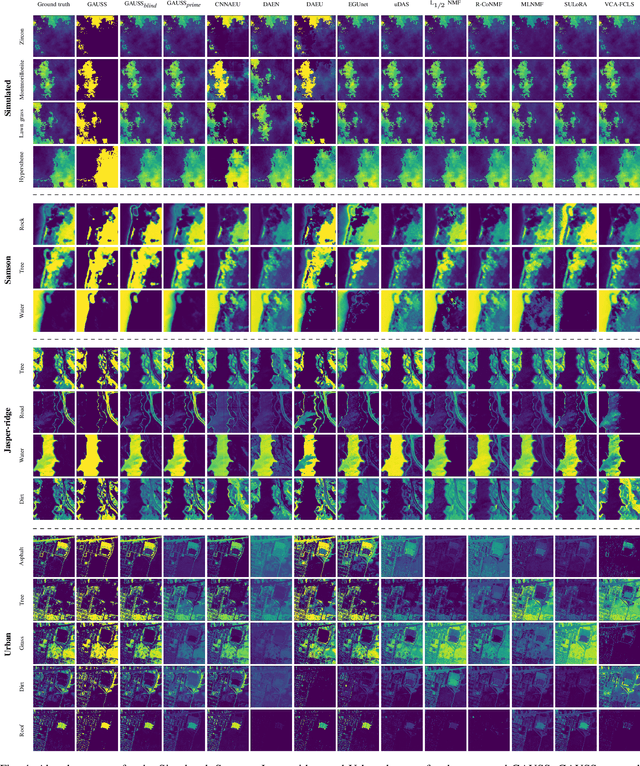
Abstract:In recent hyperspectral unmixing (HU) literature, the application of deep learning (DL) has become more prominent, especially with the autoencoder (AE) architecture. We propose a split architecture and use a pseudo-ground truth for abundances to guide the `unmixing network' (UN) optimization. Preceding the UN, an `approximation network' (AN) is proposed, which will improve the association between the centre pixel and its neighbourhood. Hence, it will accentuate spatial correlation in the abundances as its output is the input to the UN and the reference for the `mixing network' (MN). In the Guided Encoder-Decoder Architecture for Hyperspectral Unmixing with Spatial Smoothness (GAUSS), we proposed using one-hot encoded abundances as the pseudo-ground truth to guide the UN; computed using the k-means algorithm to exclude the use of prior HU methods. Furthermore, we release the single-layer constraint on MN by introducing the UN generated abundances in contrast to the standard AE for HU. Secondly, we experimented with two modifications on the pre-trained network using the GAUSS method. In GAUSS$_\textit{blind}$, we have concatenated the UN and the MN to back-propagate the reconstruction error gradients to the encoder. Then, in the GAUSS$_\textit{prime}$, abundance results of a signal processing (SP) method with reliable abundance results were used as the pseudo-ground truth with the GAUSS architecture. According to quantitative and graphical results for four experimental datasets, the three architectures either transcended or equated the performance of existing HU algorithms from both DL and SP domains.
Holistic Interpretation of Public Scenes Using Computer Vision and Temporal Graphs to Identify Social Distancing Violations
Dec 13, 2021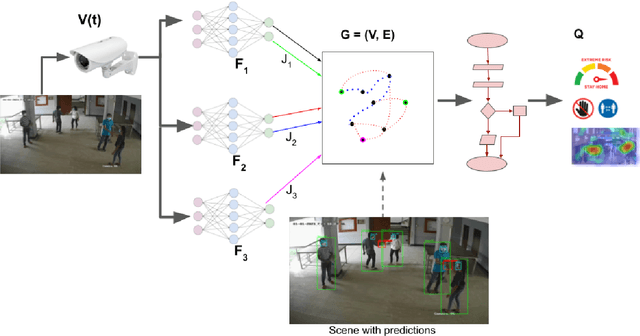
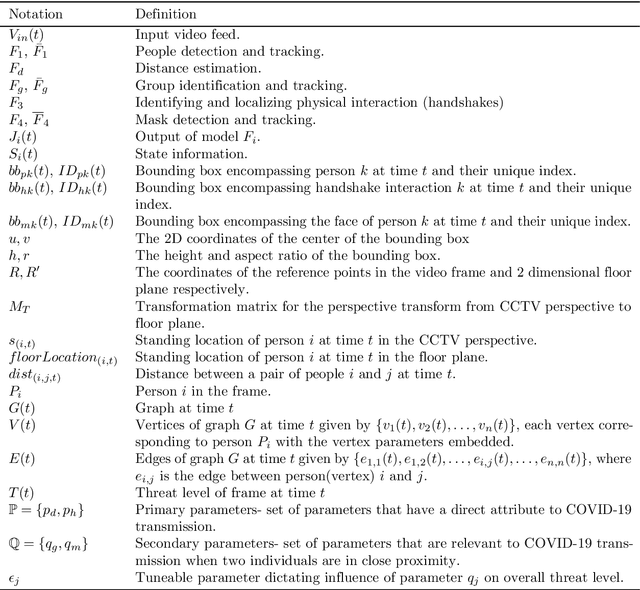
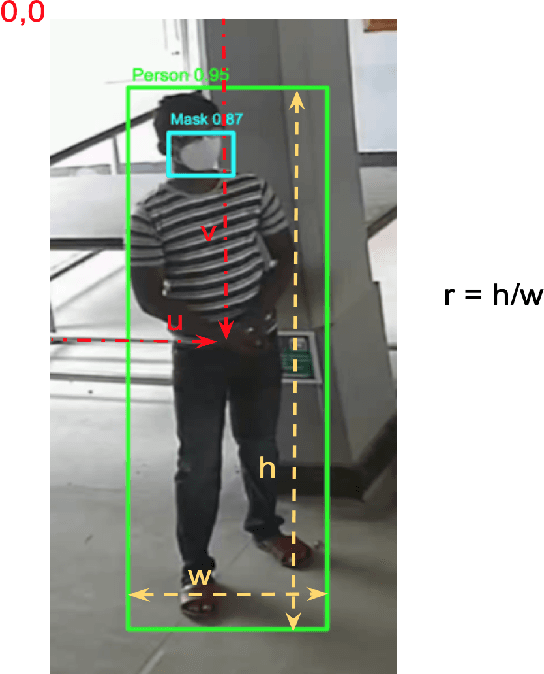

Abstract:The COVID-19 pandemic has caused an unprecedented global public health crisis. Given its inherent nature, social distancing measures are proposed as the primary strategies to curb the spread of this pandemic. Therefore, identifying situations where these protocols are violated, has implications for curtailing the spread of the disease and promoting a sustainable lifestyle. This paper proposes a novel computer vision-based system to analyze CCTV footage to provide a threat level assessment of COVID-19 spread. The system strives to holistically capture and interpret the information content of CCTV footage spanning multiple frames to recognize instances of various violations of social distancing protocols, across time and space, as well as identification of group behaviors. This functionality is achieved primarily by utilizing a temporal graph-based structure to represent the information of the CCTV footage and a strategy to holistically interpret the graph and quantify the threat level of the given scene. The individual components are tested and validated on a range of scenarios and the complete system is tested against human expert opinion. The results reflect the dependence of the threat level on people, their physical proximity, interactions, protective clothing, and group dynamics. The system performance has an accuracy of 76%, thus enabling a deployable threat monitoring system in cities, to permit normalcy and sustainability in the society.
Assessment of Fetal and Maternal Well-Being During Pregnancy Using Passive Wearable Inertial Sensor
Nov 19, 2021



Abstract:Assessing the health of both the fetus and mother is vital in preventing and identifying possible complications in pregnancy. This paper focuses on a device that can be used effectively by the mother herself with minimal supervision and provide a reasonable estimation of fetal and maternal health while being safe, comfortable, and easy to use. The device proposed uses a belt with a single accelerometer over the mother's uterus to record the required information. The device is expected to monitor both the mother and the fetus constantly over a long period and provide medical professionals with useful information, which they would otherwise overlook due to the low frequency that health monitoring is carried out at the present. The paper shows that simultaneous measurement of respiratory information of the mother and fetal movement is in fact possible even in the presence of mild interferences, which needs to be accounted for if the device is expected to be worn for extended times.
A generalized forecasting solution to enable future insights of COVID-19 at sub-national level resolutions
Aug 21, 2021

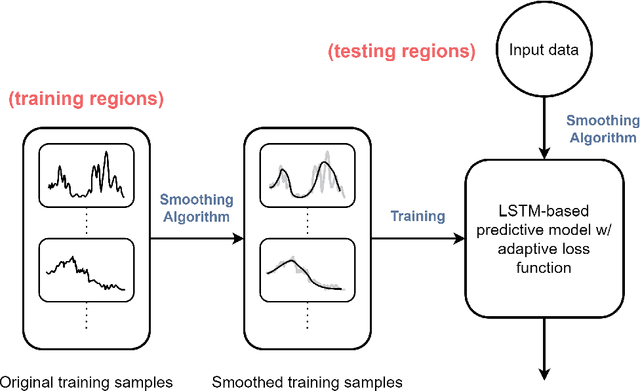

Abstract:COVID-19 continues to cause a significant impact on public health. To minimize this impact, policy makers undertake containment measures that however, when carried out disproportionately to the actual threat, as a result if errorneous threat assessment, cause undesirable long-term socio-economic complications. In addition, macro-level or national level decision making fails to consider the localized sensitivities in small regions. Hence, the need arises for region-wise threat assessments that provide insights on the behaviour of COVID-19 through time, enabled through accurate forecasts. In this study, a forecasting solution is proposed, to predict daily new cases of COVID-19 in regions small enough where containment measures could be locally implemented, by targeting three main shortcomings that exist in literature; the unreliability of existing data caused by inconsistent testing patterns in smaller regions, weak deploy-ability of forecasting models towards predicting cases in previously unseen regions, and model training biases caused by the imbalanced nature of data in COVID-19 epi-curves. Hence, the contributions of this study are three-fold; an optimized smoothing technique to smoothen less deterministic epi-curves based on epidemiological dynamics of that region, a Long-Short-Term-Memory (LSTM) based forecasting model trained using data from select regions to create a representative and diverse training set that maximizes deploy-ability in regions with lack of historical data, and an adaptive loss function whilst training to mitigate the data imbalances seen in epi-curves. The proposed smoothing technique, the generalized training strategy and the adaptive loss function largely increased the overall accuracy of the forecast, which enables efficient containment measures at a more localized micro-level.
An Optical physics inspired CNN approach for intrinsic image decomposition
May 21, 2021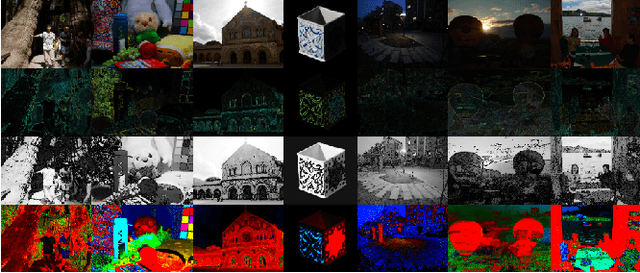

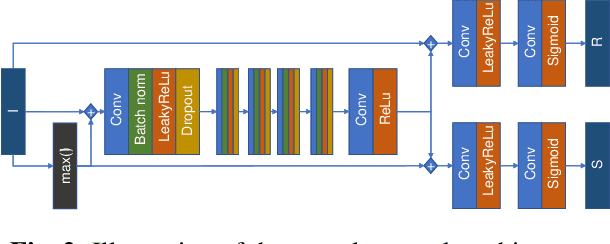
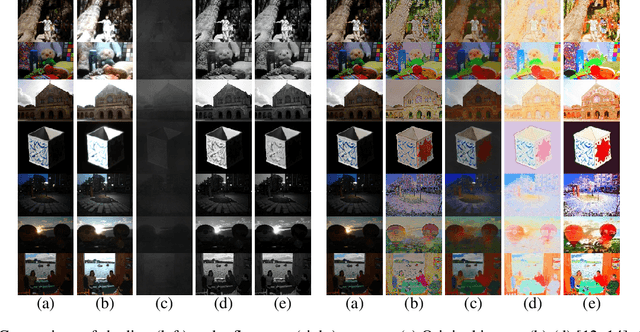
Abstract:Intrinsic Image Decomposition is an open problem of generating the constituents of an image. Generating reflectance and shading from a single image is a challenging task specifically when there is no ground truth. There is a lack of unsupervised learning approaches for decomposing an image into reflectance and shading using a single image. We propose a neural network architecture capable of this decomposition using physics-based parameters derived from the image. Through experimental results, we show that (a) the proposed methodology outperforms the existing deep learning-based IID techniques and (b) the derived parameters improve the efficacy significantly. We conclude with a closer analysis of the results (numerical and example images) showing several avenues for improvement.
Comprehensive Study on Denoising of Medical Images Utilizing Neural Network Based Auto-Encoder
Feb 03, 2021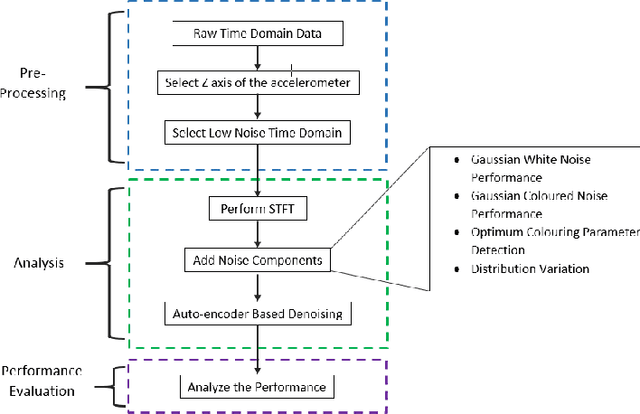
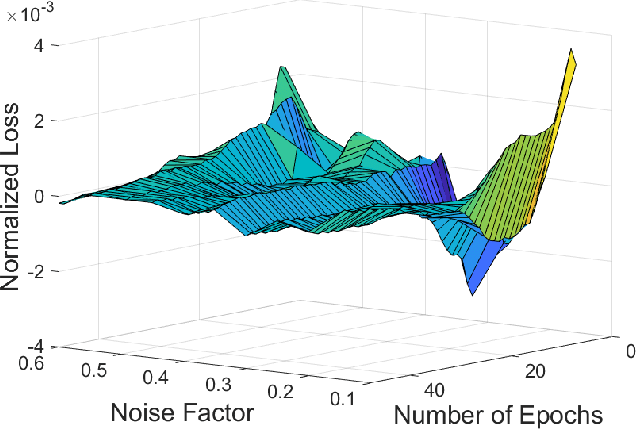
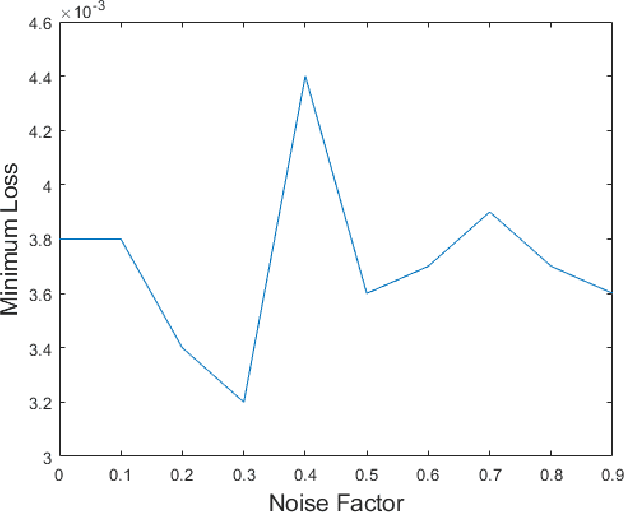
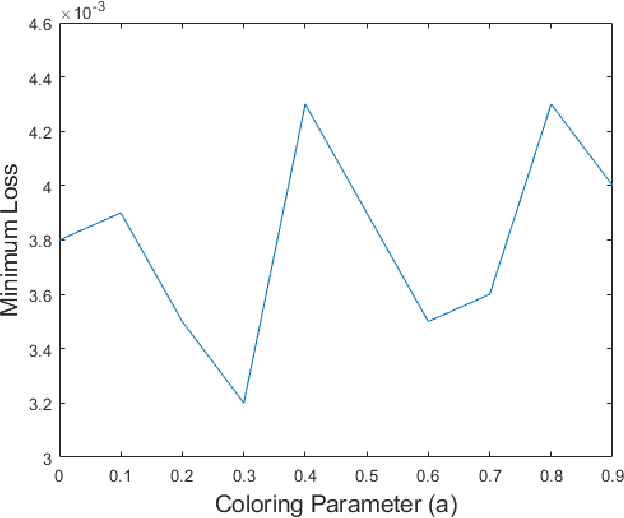
Abstract:Fetal motion discernment utilizing spectral images extracted from accelerometric data incident on pregnant mothers abdomen has gained substantial attention in the state-of-the-art research. It is an essential practice to avoid adverse scenarios such as stillbirths and intrauterine growth restrictions. However, this endeavor of ensuring fetus safety has been arduous due to the existence of random noise in medical images. This novel research is an in depth approach to analyze how the interference of different noise variations affect the retrieval of information in those images. For that, an algorithm employing auto-encoder-based deep learning was modeled and the accuracy of reconstruction of the STFT images mitigating the noise has been measured examining the loss. From the results, it is manifested that even a substantial addition of the Super-Gaussian noises which have a higher correlation of the frequencies possessed by the Fetal movement images can be restored successfully with the slightest error.
Novel Non-Invasive In-house Fabricated Wearable System with a Hybrid Algorithm for Fetal Movement Recognition
Jan 29, 2021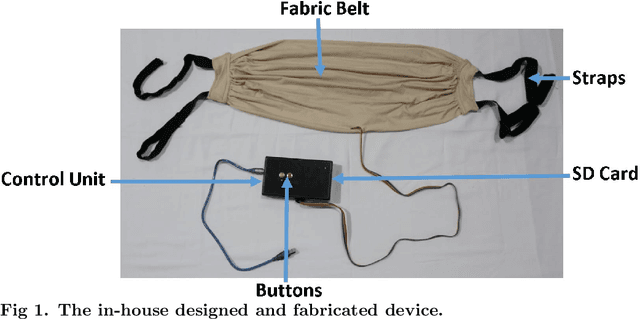

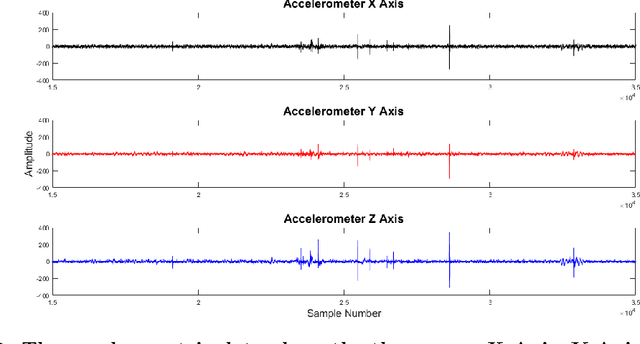

Abstract:Fetal movement count monitoring is one of the most commonly used methods of assessing fetal well-being. While few methods are available to monitor fetal movements, they consist of several adverse qualities such as unreliability as well as the inability to be conducted in a non-clinical setting. Therefore, this research was conducted to design a complete system that will enable pregnant mothers to monitor fetal movement at home. This system consists of a non-invasive, non-transmitting sensor unit that can be fabricated at a low cost. An accelerometer was utilized as the primary sensor and a micro-controller based circuit was implemented. Clinical testing was conducted utilizing this sensor unit. Two phases of clinical testing procedures were done and readings from more than 120 pregnant mothers were taking. Validation was done by conducting an abdominal ultrasound scan which was utilized as the ground truth during the second phase of the clinical testing procedure. A clinical survey was also conducted in parallel with clinical testings in order to improve the sensor unit as well as to improve the final system. Four different signal processing algorithms were implemented on the data set and the performance of each was compared with each other. Consequently, the most feasible as well as the best performing algorithm was determined and it was utilized in the final system. Furthermore, a mobile application was also developed to be used with the sensor unit by pregnant mothers. Finally, a complete end to end method to monitor fetal movement in a non-clinical setting was presented by the proposed system.
Convolutional Autoencoder for Blind Hyperspectral Image Unmixing
Nov 18, 2020



Abstract:In the remote sensing context spectral unmixing is a technique to decompose a mixed pixel into two fundamental representatives: endmembers and abundances. In this paper, a novel architecture is proposed to perform blind unmixing on hyperspectral images. The proposed architecture consists of convolutional layers followed by an autoencoder. The encoder transforms the feature space produced through convolutional layers to a latent space representation. Then, from these latent characteristics the decoder reconstructs the roll-out image of the monochrome image which is at the input of the architecture; and each single-band image is fed sequentially. Experimental results on real hyperspectral data concludes that the proposed algorithm outperforms existing unmixing methods at abundance estimation and generates competitive results for endmember extraction with RMSE and SAD as the metrics, respectively.
 Add to Chrome
Add to Chrome Add to Firefox
Add to Firefox Add to Edge
Add to Edge